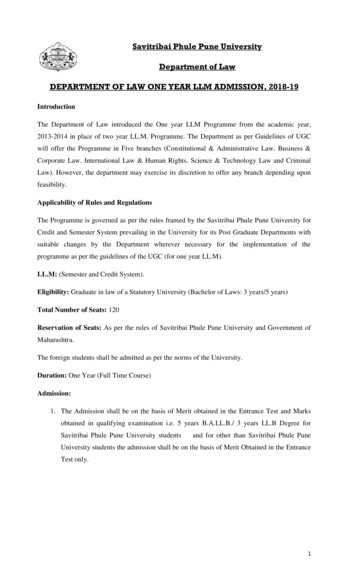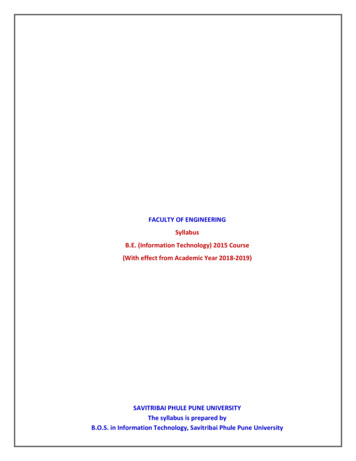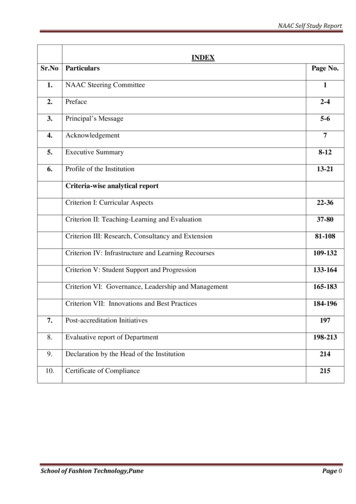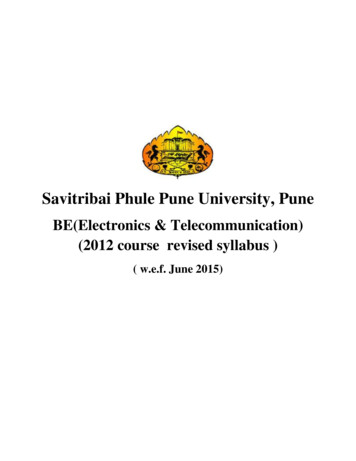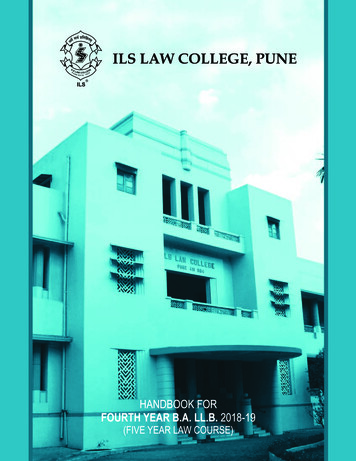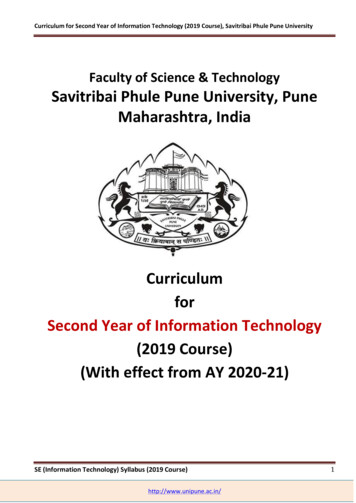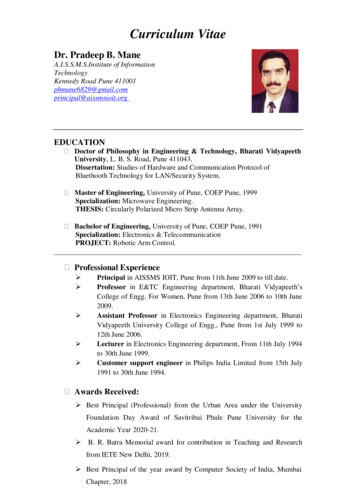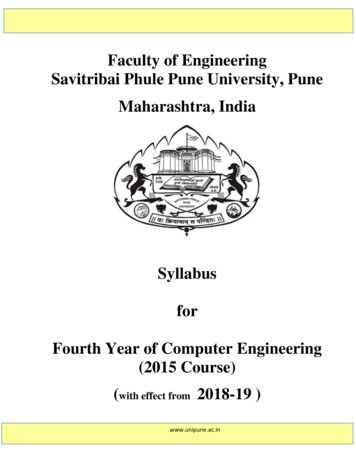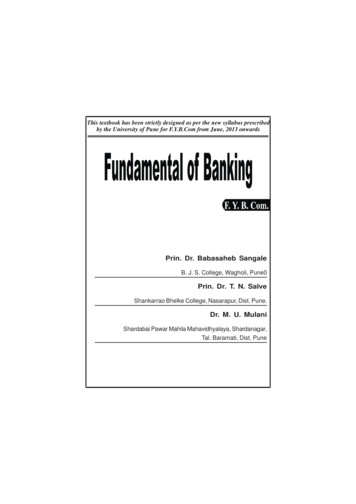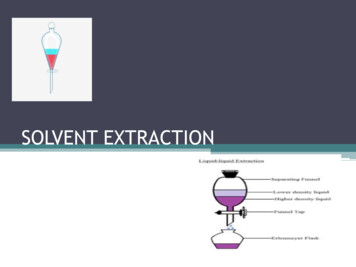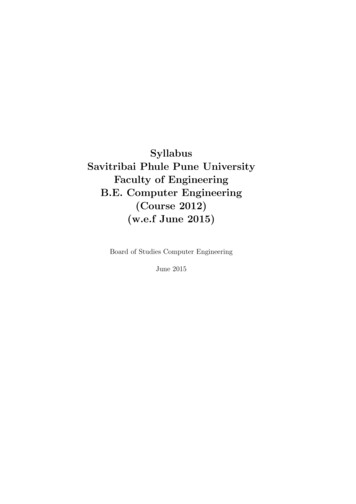
Transcription
SyllabusSavitribai Phule Pune UniversityFaculty of EngineeringB.E. Computer Engineering(Course 2012)(w.e.f June 2015)Board of Studies Computer EngineeringJune 2015
PreambleIt is my pleasure to present this B.E. Computer Engineering Syllabus. The syllabus is a blend of concepts andadvances using high end FOSS technologies. One of the objectives of the this syllabus is to cultivate studentsfor using FOSS and contributions in FOSS. The theory subjects are based on the pre-requisites covered infirst year to third Year computer engineering. 16 electives are divided into four groups on recent technologiessuch as cloud computing, mobile computing, web applications and Business Analytic and Intelligence, CyberSecurity are provided which shall be useful for student in their professional carrier.The laboratories for problem solving practices are based on utilization of state-of-the art FOSS software Technologies used by the Industries. The FOSS technologies are available with source code students can experimentthe performance improvement and ideation to replace the existing implementation. The Project can be done asconventional practices or as an entrepreneur project to give thrust on generating budding talent as entrepreneurto lead the industrial front of the nation worldwide.For BoS Computer EngineeringProf. Sarang Joshi1
Program Educational Objectives To create competencies and opportunities for Higher Education; To create professional manpower skilled for the IT Industry; To write laboratory practicals with advanced FOSS Tools; To create inter-disciplinary opportunities; To create opportunities of developing technical documents and presentation skills. to create opportunities of industry-Institute interactions; To create opportunities to promote Entrepreneurship and start-ups; To nurture and practice professional and social ethics.Program Objectives To expose students to the Systems and Applications Programming, Organizations and Architectures; To provide conceptual knowledge in the Computing domain; To provide interdisciplinary knowledge; To expose students with advanced tools used in industry; To develop written and soft-skill competencies; To develop team work experience of professionals skills for IT Industry.Program Outcomes To write applications with concepts and skills in the domain subjects; To practice skills in programming techniques and open source technologies; To practice oral and written skills for technical presentations and documentation using FOSS tools; To write and practice IT project as a team-work; To practice social and Professional ethical practices;2
SAVITRIBAI PHULE PUNE UNIVERSITYBE (COMPUTER ENGINEERING)- 2012 COURSE 0453410454410455SubjectDesign & Analysisof AlgorithmsPrinciples of ModernCompiler DesignSmart System Designand e DesignMethodologies ve-IVOpen VProjectTotalTeaching SchemeExamination 00200—2801507503
Electives:1.2.Semester-IELECTIVE-IImage ProcessingComputer Network Designand ModelingAdvanced Computer ProgrammingData Mining Techniquesand ApplicationsELECTIVE-IIProblem Solving with GamificationPervasive Computing3.4.Embedded SecurityMultidisciplinary NLP1.2.3.4.1.2.Semester-IIELECTIVE-IIIMobile ComputingWeb Technology3.4.Cloud ComputingCyber Security1.2.3.4.ELECTIVE-IV (Open Elective)Business Analytic and IntelligenceOperations Research for Algorithmsin Scientific ApplicationsMobile ApplicationsOpen ElectiveOpen Elective: The listed open electives or any other Elective that is being taught in the current semester(semester-II) under the faculty of engineering or individual college and Industry can define new elective withcomplete (6 units) syllabus using defined framework of Elective IV and GET IT APPROVED FROM THEBOARD OF STUDIES (COMPUTER ENGINEERING) AND OTHER NECESSARY STATUTORY SYSTEMS IN THE SAVITRIBAI PHULE PUNE UNIVERSITY BEFORE 30th DECEMBER.4
410441 Design and Analysis of AlgorithmsTeaching SchemeLectures: 3 Hrs/ WeekExamination SchemeIn semester Assessment: 30End Semester Assessment : 70Course Objectives: To develop problem solving abilities using mathematical theories; To apply algorithmic strategies while solving problems; To develop time and space efficient algorithms; To study algorithmic examples in distributed, concurrent and parallel environments.Course Outcomes: To survey algorithmic strategies give presentations using open source documentation tools like Latex andsoft skill methodologies. To write mathematical modeling of algorithms for problem solving. To develop SRS in the UG projects; To solve problems for multi-core or distributed or concurrent/Parallel/Embedded environments;UnitIIIIIIIVVContentProblem solving and Algorithmic AnalysisProblem solving principles: Classification of problem, problem solvingstrategies, classification of time complexities (linear, logarithmic etc)problem subdivision – Divide and Conquer strategy.Asymptotic notations, lower bound and upper bound: Best case, worst case,average case analysis, amortized analysis. Performance analysis of basicprogramming constructs. Recurrences: Formulation and solving recurrenceequations using Master Theorem.Greedy and Dynamic Programming Algorithmic StrategiesGreedy strategy: Principle, control abstraction, time analysis of controlabstraction, knapsack problem, scheduling algorithms-Job scheduling andactivity selection problem.Dynamic Programming: Principle, control abstraction, time analysis ofcontrol abstraction, binomial coefficients, OBST, 0/1 knapsack, Chain Matrixmultiplication.Backtracking and Branch-n-BoundBacktracking: Principle, control abstraction, time analysis of controlabstraction, 8-queen problem, graph coloring problem, sum of subsetsproblem.Branch-n-Bound: Principle, control abstraction, time analysis of controlabstraction, strategies – FIFO, LIFO and LC approaches, TSP, knapsackproblem.Complexity TheoryOverview: Turing machine, polynomial and non-polynomial problems,deterministic and non-deterministic algorithms, P class, NP class &NP complete problems- vertex cover and 3-SAT and NP–hard problem –Hamiltonian cycle. The menagerie of complexity classes of Turing degrees.Concept of randomized and approximation algorithms: Solving TSP byapproximation algorithm, Randomized sort algorithms and ApproximatingMax Clique.Parallel and Concurrent AlgorithmsParallel Algorithms: Sequential and parallel computing, RAM &PRAM models, Amdahl’s Law, Brent’s theorem, parallel algorithm analysisand optimal parallel algorithms, graph problems (shortest paths andMinimum Spanning Tree, Bipartite graphs )Concurrent Algorithms: Dining philosophers problem5Hrs66866
VIAlgorithmic Case-studiesDistributed Algorithms: Bully algorithm – method for dynamicallyselecting a coordinator, all pair shortest path (Floyed-Warshall Algorithm),Dijkstra-Scholten algorithm – detection of process termination, Buddymemory algorithm – method to allocate memory.Embedded Algorithms: Embedded system scheduling (power optimizedscheduling algorithm), sorting algorithm for embedded systems.Internet of Things and Data Science Algorithms: Algorithms in IoT:Cryptography Algorithms, Scheduling Algorithms, Data management Algorithmsand clustering, context management. Data Science Project Life Cycle(DSPLC),Mathematical Considerations: Mathematical modeling, Optimization Methods, Adaptiveand Dynamic Algorithms and Numerical Analysis in IoTAlgorithms in Software Engineering: String matching algorithmBoyer-Moore algorithm KMP algorithm.Text Books:Sl.Text BooksNo.1.Horowitz and Sahani, ”Fundamentals of Computer Algorithms”, 2ND Edition.University Press, ISBN: 978 81 7371 6126, 81 7371 61262.2.Gilles Brassard and Paul Bartley, ”Fundamental of Algorithmics”, PHI, New Delhi.3.Algorithms, Kenneth Berman and Jerome Paul, Cenage Learning,ISBN-13 978-81-315-0521-2Reference Books:Sl.Reference BooksNo.1.Algorithms and Parallel Computing, Fayez Gebali, Willy, ISBN 978-0-470-90210-3(Indian Paperback Edition)2.Anany Levitin, ”Introduction to the Design and Analysis of Algorithms” PearsonEducation3.Thomas H Cormen and Charles E.L Leiserson, ”Introduction to Algorithm” PHI4.BoS Content: Books, Course Notes, Digital contents, Blogs developed by the BoSfor bridging the gaps in the syllabus, problem solving approaches and advances in the course68
410442 Principles of Modern Compiler DesignTeaching SchemeLectures: 4 Hrs/WeekExamination SchemeIn semester Assessment: 30End Semester Assessment : 70Course Prerequisite: Fundamentals of Data structures Theory of Computation Concepts of Operating Systems Study of Programming LanguagesCourse Objectives: To write programs with concepts in assembling, parsing and compiling the target code for execution. To survey the systems and methods of compilation. To practice basic FOSS tools for compiler writing and expose the latest techniques and advances incompiler. To verify and use concurrent, embedded and distributed compilation tools and techniques.Course Outcomes: To write symbol tables, different types of grammars to solve problem of parsing. To design and write simple compiler using FOSS tools. To practice compiler tools in basic, concurrent, distributed and embedded environments. To survey and use latest trends and advances in compilersUnitIIIIIIIVContentNotion and ConceptsIntroduction to compilers – Design issues, passes, phases, symbol tablePreliminaries – Memory management, Operating system support for compiler,Compiler support for garbage collectionLexical Analysis – Tokens, Regular Expressions, Process of Lexical analysis, BlockSchematic, Automatic construction of lexical analyzer using LEX, LEX features andspecificationParsingSyntax Analysis – CFG, top-down and bottom-up parsers, RDP, Predictive parser, SLR,LR(1), LALR parsers, using ambiguous grammar, Error detection and recovery,automatic construction of parsers using YACC, Introduction to Semantic analysis –Need of semantic analysis, type checking and type conversionSyntax Translation SchemesSyntax Directed Translation and Intermediate Code Generation – Attribute grammar, Sand L attributed grammar, bottom up and top down evaluations of S and L attributedgrammar, Intermediate code – need, types, Syntax directed translation scheme,Intermediate code generation for - assignment statement, declaration statement,Boolean expression, if-else statement, do -while statement, array assignment.Code Generation and OptimizationCode Generation and Code Optimization – Issues in code generation, basic blocks,flow graphs, DAG representation of basic blocks, Target machine description,Register allocation and Assignment, Simple code generator, Code generation fromlabeled tree, Concept of code generator.Need for Optimization, local, global and loop optimization, Optimizing transformations– compile time evaluation, common sub-expression elimination, variable propagation,code movement, strength reduction, dead code elimination, DAG based local optimization,peephole optimization, Introduction to global data flow analysis, Data flow equationsand iterative data flow analysis (only introduction expected)7Hrs6878
VVIFunctional and Logic ProgramsLanguage Specific Compilation: Object Oriented languages – source language issues,routines and activation, code generation and control flowFunctional languages - introduction to Functional Programs, basic compilation,polymorphic type checking, desugaring , compiling to a register-oriented architecturesJavaCC (Chapter 13 of reference book 1)Parallel and Distributed CompilersParallel programming models, Processes and threads, Shared variablesMessage passing, Parallel Object Oriented languages, Tuple space, AutomaticparallelizationIntroduction to advanced topics – JIT, Dynamic compilation, Interpreters (JVM/Dalvik),Cross compilation using XMLVM, Case studies(self study): GCC, g ,nmake,cmake. NVCC (case study for parallel compilation), LLVM78Text Books:Sl.No. Text Books1.A V Aho, R Sethi, J D Ullman, “Compilers: Principles, Techniques, and Tools”,Pearson Edition, ISBN 81-7758-590-82.Dick Grune, Bal, Jacobs, Langendoen, Modern Compiler Design, Wiley,ISBN 81-265-0418-8Reference Books:Sl.No. Reference Books1.Compiler Construction Using Java, JavaCC and Yacc, Anthony J. Dos Reis, WileyISBN 978-0-470-94959-72.K Muneeswaran, “Compiler Design”, Oxford University press, ISBN 0-19-806664-33.J R Levin, T Mason, D Brown, “Lex and Yacc”, O’Reilly, 2000 ISBN 81-7366-061-X4.BoS Content: Books, Course Notes, Digital contents, Blogs developed by the BoSfor bridging the gaps in the syllabus, problem solving approaches and advances in the course8
410443 Smart System Design and ApplicationsTeaching SchemeLectures: 3 Hrs/WeekExamination SchemeIn semester Assessment: 30End Semester Assessment : 70Course Objectives: To study multidisciplinary requirements of problem solving; To study concepts of Artificial Intelligence; To study smart systems programming and application development; To study examples in distributed, concurrent and parallel environments.Course Outcomes: To write and survey solution for multidisciplinary case-study using mathematical modeling give presentations using soft skills methodologies; To write and survey embedded systems applications using machine learning; To solve problems for multi-core or distributed, concurrent and embedded environments;UnitIIIIIIIVContentIntroduction to Intelligent SystemsIntroduction, History, Foundations and Mathematical treatments, Problem solvingwith AI, AI models, Learning aspects in AI, What is an intelligent Agents,Rational agent, Environments types, types of AgentsProblem-solving and Building Smart SystemsProblem solving process, Problem analysis and representation, Problem space and search,Toy problems, real world problems, Problem reduction methods,General Search algorithms, Uninformed Search methods, Informed (Heuristic) SearchBest-first, Greedy, A* search methods, Heuristic Functions, AO*, Local SearchAlgorithms and optimization problems, Adversarial search methods,Important concepts of Game theory, Game theory and knowledge structure, Game as asearch problem, Alpha-Beta Pruning, Stochastic Games,Constraint Satisfaction Problem, CSP as search problemKnowledge, Reasoning, and PlanningKnowledge based agents, The Wumpus World, Logic, propositional logic, Representationof knowledge using rules, Predicate logic, Unification and lifting, inference in FOL,Forward Chaining, Backward Chaining, Resolution, Logic Programming.Planning problem, Planning, Algorithms for Planning as State-Space Search, PlanningGraphs, simple planning agent, planning languages, blocks world problem, goal stackplanning, mean end analysis, progression planners, regression planners, partialorder planning, planning graphs, hierarchical planning, job shop scheduling problem,Planning and Acting in the Real World, Hierarchical Planning, Multi-agent Planning,Ontological Engineering, Categories and Objects, Events, Mental Events and MentalObjects, Reasoning Systems for Categories, Reasoning with Default Information,The Internet Shopping WorldUncertain Knowledge and Decision TheoryUncertainty and methods, Basic Probability Notion, Inference Using Full JointDistributions, Bayesian probability and belief networks, Relational and FirstOrder Probability Models, Other techniques in uncertainty and reasoning, Inferencein Temporal Models, Hidden Markov Models, Kalman Filters, Dynamic BayesianNetworks, Decision network, Semi-constraint influence diagram, Decision making andimperfect information, Combining Beliefs and Desires under Uncertainty, The Basis ofUtility Theory, Utility Functions, Multi-attribute Utility Functions, DecisionNetworks, Decision-Theoretic Expert Systems9Hrs4676
VVILearning Tools, Techniques and ApplicationsMachine Learning Concepts, methods and models, Supervised Learning, unsupervisedand semi-supervised, Learning Decision Trees, Evaluating and Choosingthe Best Hypothesis, Artificial Neural Networks, Non-parametric Models, SupportVector Machines, Ensemble Learning, empirical learning tasks, Explanation-BasedLearning, Inductive Logic Programming, Reinforcement Learning, Active Learning,Learning based on limited information.Building Smart systems using different learning techniques, smart system applications,agent based concurrent engineeringCommunicating, Perceiving, and ActingLanguage Models, Text Classification, Information Retrieval, Information Extraction,Phrase Structure Grammars, Syntactic Analysis (Parsing), Augmented Grammars andSemantic Interpretation, Machine Translation, Speech Recognition, Image Formationand object recognition, Early Image-Processing Operations, Object Recognition byAppearance, Reconstructing the 3D World, Object Recognition from StructuralInformation, Using Vision, Robot Hardware, Robotic Perception, Planning to Move,Planning Uncertain Movements, Robotic Software Architectures, Application Domains76Text Books:Sl.No. Text Books1.Stuart Russell and Peter Norvig (1995), Artificial Intelligence: A Modern Approach,”Third edition, Pearson, 2003.2.Shai shalev-shwartz, Shai Ben-David: Understanding Machine Learning from Theory toalgorithms, Cambridge University Press, ISBN-978-1-107-51282-5, 2014.Reference Books:Sl.No. Reference Books1.Artificial Intelligence by Elaine Rich, Kevin Knight and Nair, TMH2.BoS Content: Books, Course Notes, Digital contents, Blogs developed by the BoSfor bridging the gaps in the syllabus, problem solving approaches and advances in the course10
410444A Elective-I: Image ProcessingTeaching SchemeLectures: 3 Hrs/WeekExamination SchemeIn semester Assessment: 30End Semester Assessment : 70Course Objectives: To study image processing concepts; To study mathematics and algorithms for image processing; To study applications in image processing; To study algorithmic examples in distributed, concurrent and parallel environments.Course Outcomes: To survey image processing techniques, FOSS tools and related mathematics. To write image processing programs with applying concepts using open source tools; To solve Image Processing problems using multi-core or distributed, concurrent/Parallel environments.UnitIIIIIIIVVContentIntroduction to Image processingIntroduction, Image sampling and quantization, Resolution, Human visual system,Classification of digital images, Image types(optical and microwave), Elements ofan image processing system, Image file formats(tiff, jpeg, ico, ceos, png, rasterimage format), Introduction to OpenCV tool to Open and display Images using Python orEclipse C/CPP.Image Enhancement Thresholding, Segmentation, Watershed Segmentation, Edge-basedSegmentation, Fuzzy Segmentation Spatial domain techniques – Image Negative,Contrast stretching, gray level slicing, bit plane slicing, histogram andhistogram equalization, local enhancement technique, image subtraction andimage average, low–pass spatial filters, median filtering, high-pass spatial filter,derivative filters,Frequency domain techniques- Ideal low-pass filter,butterworth low-pass filter, High-pass filter, Homo-morphic filters.Image AnalysisImage segmentation- Classification of image segmentation techniques: WatershedSegmentation, Edge-based Segmentation, Fuzzy Segmentation, region approach,clustering techniques, thresholding , edge-based, classification of edges andedge detection, watershed transformationFeature Extraction- Boundary representation( Chain code, B-spline representation,fourier descriptor) Region representation(Area, Euler number, Eccentricity, Shapematrix, moment based descriptor), texture based featuresImage Compression and Object recognitionIntroduction to Image compression and its need, Coding redundancy, classificationof compression techniques(Lossy and lossless- JPEG, RLE, Huffman, Shannon fano),scalar and vector quantizationObject Recognition – Need, Automated object recognition system, pattern and patternclass, relationship between image processing and object recognition, approachesto object recognitionMedical ImagingMedical Image obtained with ionizing radiation- medical imaging modalites, imagesfrom X–rays,Gamma rays, Dose and Risk,Medical Image obtained with non-ionizing radiation: Ultrasound imaging, magneticresonance imaging, PACS,3D visualization: Image visualization, Surface and volume rendering, Virtual reality,Dental & Digital X-Ray Processing, RBC Image Processing, 3-D Visualization11Hrs66886
VIRemote sensing ImagingDefinition of Remote sensing, Remote sensing process, Photogrammetry, Electromagneticspectrum, Interaction with atmosphere,Recording of energy by sensor, Transmission,Reception and Processing, Atmospheric sensors, Active remote sensors, Passive microwaveremote sensing, Satellite Images,Visual Image Interpretation: Introduction,Remote sensing data products, Image interpretation, Elements of visual imageinterpretation, Interpretation keys, Thermal and Radar image interpretation,Pre-processing,Application of Remote Processing.Text Books:Sl.No. Text Books1.Fundamentals of Digital Image Processing, Anil K. Jain, PHI,ISBN 81-203-0929-42.Digital Image Processing for Medical Applications, Geoff Dougherty,Cambridge University Press, ISBN: 978-0-521-18193-8.3.Digital Image processing by S.Jayaraman, McGraw Hills Publication4.Fundamentals of Digital Image Processing by S. Annadurai, Pearson publication5.Digital Image Processing for Medical Applications by Geoff Dougherty,Cambridge university press6.Remote sensing and GIS by Basudeb Bhatia, 2nd edition, OXFORD University press.Chapter [1,5,9,12]Reference Books:Sl.No. Reference Books1.Handbook of Medical Imaging, Processing and Analysis, Academic Press,ISBN 0-12-077790-8 (PDF Book)2.Essential Image Processing and GIS for Remote Sensing, Jian Guo LiuPhillippa Mason, ISBN 978-0-470-51032-23.BoS Content: Books, Course Notes, Digital contents, Blogs developed by the BoSfor bridging the gaps in the syllabus, problem solving approaches and advances in the course126
410444B Elective-I: Computer Network Design and ModelingTeaching SchemeLectures: 3 Hrs/WeekExamination SchemeIn semester Assessment: 30End Semester Assessment : 70Course Objectives: To expose students to the area of network design, modeling and analysis. To expose students to the complete life cycle of the network design. To motivate students to think performance perspective towards design & analysis of the computer network. To expose students to the various open source network design tools. To study algorithmic examples in distributed, concurrent and parallel environments.Course Outcomes: To design, model and analyze computer network. To practice using FOSS tools for network design, modeling and analysis. To solve problems for multi-core or distributed, concurrent/Parallel environments.UnitIIIIIIIVVVIContentIntroduction, requirement analysis: conceptsOverview of network analysis and design process, System description and methodology,Service description and characteristics, performance characteristics, requirementanalysis (user, application, device, network, other) concepts, requirementspecification and map.Requirement Analysis: processRequirement gathering and analysis (developing service metrics, characterizing behavior,Developing RMA, delay, capacity, performance requirements, Environment-SpecificThresholds and Limit, Requirements Mapping)Flow analysis and Network architectureIdentifying and Developing Flows, Data Sources and Sinks, Flow Models, FlowPrioritization & specification, examples of flow analysis, Component Architectures,Reference Architecture, Architectural Models, Systems and Network Architectures.Addressing, routing and Network management architectureAddressing Mechanisms, Routing Mechanisms, Addressing Strategies, RoutingStrategies,Architectural Considerations of addressing, Network ManagementMechanisms, Architectural Considerations of network management.Network Performance and DesignDeveloping Goals for Performance, Performance Mechanisms, ArchitecturalConsiderations, Design Process, Vendor, Equipment, and Service-ProviderEvaluations, Network Layout, Design Traceability, Design Metrics.Tools for Network Design, Modeling and AnalysisDiscrete event simulation, modeling for computer simulation, NS-3 or latest versionor equivalent, modeling network elements, Simulating a Computer Network, SmartPointers, Representing Packets, Object Aggregation, Events in NS–3 or latest versionor equivalent, Compiling and Running the Simulation, Animating the Simulation,Scalability with Distributed Simulation, Emulation Capabilities, Analyzing the Results,Overview of OMNet.Hrs866866Text Books:Sl.No. Text Books1.James D. McCabe, ”Network Analysis, Architecture, and Design”, Morgan KaufmannPublisher (ELSEVIER), 3rd edition2.Wehrle, Klaus, Günes, Mesut, Gross, James, ”Modeling and Tools for Network Simulation”,Springer, ISBN: 978-3-642-12330-613
Reference Books:Sl.No. Reference Books1.Priscilla Oppenheimer, ”Top Down Network Design”, 3rd Edition, Cisco Press2.BoS Content: Books, Course Notes, Digital contents, Blogs developed by the BoSfor bridging the gaps in the syllabus, problem solving approaches and advances in the course14
410444C Elective-I: Advanced Computer ProgrammingTeaching SchemeLectures: 3 Hrs/WeekExamination SchemeIn semester Assessment: 30End Semester Assessment : 70Course Objectives: To survey advanced computer programming technologies and give presentation using soft skill and FOSStools. To write programs using advanced programming tools, data technologies, sensors, multimedia data. Write applications using the concept of Object Distribution and invoking its services remotely in Distributed environment To study algorithmic examples in distributed, concurrent and parallel environmentsCourse Outcomes: To present a survey on building blocks of advance programming tools. To practice programming problems using advance open source programming tools. To solve problems for multi-core or distributed, concurrent/Parallel environments.UnitIIIIIIIVVContentDistributed ProgrammingIntroduction, Simple Lock, Bounded Buffer, Message-Passing Services,Distributed LockService:- Distributed Lock using Timestamps,Object-Transfer Service: Object Transferusing Path Reversal,Distributed Shared Memory Service:- A Single-Copy DistributedShared Memory, A Multi-Copy Distributed Shared Memory.Java Programming ConceptsRelflections, Boxing and Unboxing, Object serialization and Deserialization,Important Java Utility classes (StringTokenizer, Observable), Java Collectionframework (LinkedList, ArrayList,Sets, Hashsets, Treeset, Hashmap,Treemap,Vectors, Stack, Dictionary,Hashtable, Itrators)SOA and ProgrammingService defined, Role/Use of service in Cloud based environment, ServiceOrchestration and Distribution. Introduction to RMI (Remote Method Invocation),SOAP, Servlet, WSDL,Developing Web services using Java. Introduction toEnterprise Java Beans(EJBs): Concept of Entity Beans, Message Beans and SessionBeans with one example each of word count program.Web ProgrammingHTML and Java Script Programming: Embedding JS in HTML, Handling Events,Variables in JS, Creating Objects uing JS, Operators, Control flow statements,Functions, JDBC, JSP, Web Architecture models, MVC Architecture Models,advantages of JSP over Servlets, Tag based approach, JSP architecture, JSPlife Cycle, Creating simple JSP Page, JSTL, JDBC features, JDBC APTs,JDBCClasses and Interfaces,ImplementingJDBC Processes with MongoDB, system.js collection for MongoDB, AJAX: Creatingsample AJAX Application, Document Object Model, JS and AJAX, Implementing AJAXframeworks.Hadoop ProgrammingData Science, in-memory analytics, in-database processing, symmetric multi-processingsystems(SMP), Massively parallel Processing, difference between parallel andDistributed Systems,Shared memory, shared disk, Shared Nothing Architecture(SNA),advantages of SNA, CAP Theorem, NoSQL, NewSQL,Features and Advantages of Hadoop, Hadoop Ecosystem, RDBMS verses Hadoop,Hadoop Distributions: Hadoop, HDFS, HDFS Daemons,File read, File write,Hadoop YARN, Word-Count Program15Hrs86866
VIAdvanced Tools, Techniques and ApplicationsProcessing data with Hadoop, MapReduce Daemons, Concept of Mapper, Reducer,Combiner, Partitioner, Searching and Sorting using MapReduce, Map-Reduceworking and example: Word count MapReduce programming using Java, MongoDBand MapReduce function, Pig: features, anatomy, Pig on Hadoop, ETL Processing,Data types and Complex data types in Pig, Running Pig: Interaction, Batch Modes,Execution modes of Pig: Local and MapReduce Modes, HDFS Commands, RelationalOperators, EVAL function, UDF, Parameter Substitution, Diagnostic Operators,Word Count example using Pig.6Text Books:Sl.No. Text Books1.Distributed Programming, Theory and Practice by Shankar and A. Udaya2.Seema Acharya, S. Chellapan, BIG DATA and Analytics, Wiley, 2015,ISBN:978-81-245-5478-23.Web Technologies: HTML, JS, PHP, Java, JSP, ASP.NET, XML, AJAX,Black Book, DreamTech, ISBN: 978-81-7722-997-4Reference Books:Sl.No. Reference Books1.Java Complete Reference by Herbert Schidlt2.Hadoop : The Definitive Guide.3.BoS Content: Books, Course Notes, Digital contents, Blogs developed by the BoSfor bridging the gaps in the syllabus, problem solving approaches and advances in the course16
410444D Elective-I: Data Mining Techniques and ApplicationsTeaching SchemeLectures: 3 Hrs/WeekExamination SchemeIn semester Assessmen
Concepts of Operating Systems Study of Programming Languages Course Objectives: To write programs with concepts in assembling, parsing and compiling the target code for execution. To survey the systems and methods of compilation. To practice basic FOSS tools for compiler writing and expose the latest techniques and advances in compiler.
